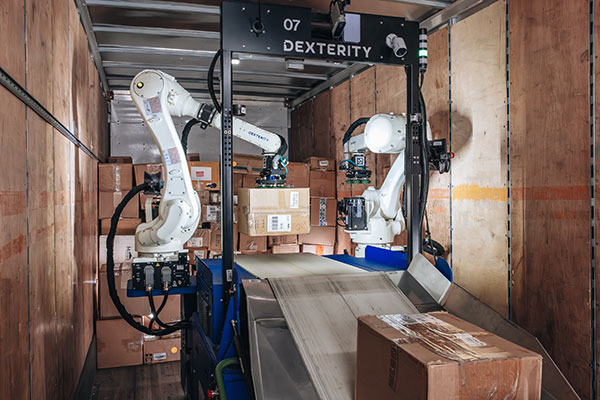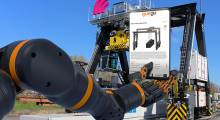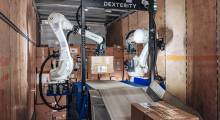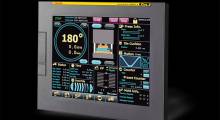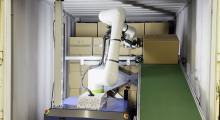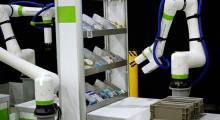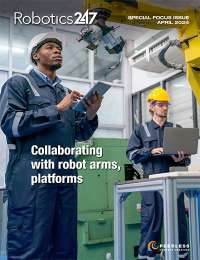“All in all, it’s just another brick in the wall.”
Pink Floyd’s classic from 1979 dives into plenty of other topics than robotics in 2024, but the underlying tie-in of bricks in a wall does spill over 45 years later.
When FedEx first partnered with California-based Dexterity to develop a mobile truck loading robot in 2021, there was room for growth, improvement and evolution. Truck unloading is a tedious, physically-demanding and cumbersome task. Hence, the need for automation was apparent. But how do you go about automating a process with a high degree of variability?
It doesn’t happen overnight.
Multiple revolutions and degrees
As Dexterity engineers worked with their FedEx counterparts, there was plenty of room to evolve the robot. Mainly, the robot had to reach all four corners of the truck without leaving its base.
Were multiple robot arms the trick? What about a bigger base? But what about how dock staff would interact with the robot? Many questions required many answers and time to revise the robot to meet FedEx’s demands for reach, cube utilization and throughput.
Seven revolutions later, DexR was unveiled in September 2023.
“Unlike a lot of robot manufacturers, we are not building the robots. We're using off-the-shelf technology,” said Michael Perry, VP of marketing and business development at Dexterity. “So seven generations of robots sounds like a lot of work, but that was really just a year of mixing and matching things that come off the shelf.”
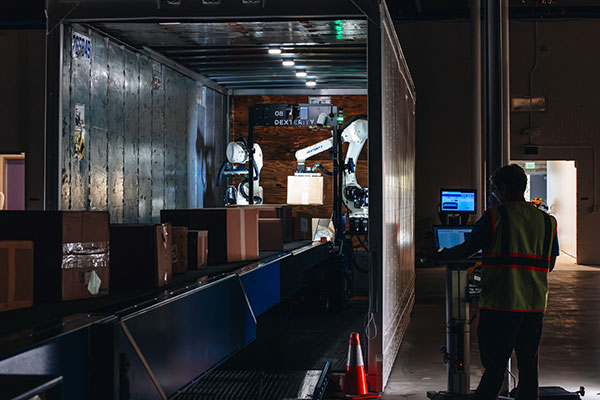
During that learning process, Dexterity and FedEx staff collaborated to identify the major challenges associated with material handling at a massive scope. As the robot “evolved” into what became the DexR, it generated a learning curve for both organizations. From the Dexterity standpoint, the focus became handling variability with predictability and durability from its robot.
“We were starting to understand what exactly were some unique challenges that FedEx was facing in terms of truck loading,” said Mukesh Ranjan, VP of product at Dexterity. “The way this evolution has come about is that your truck loading for FedEx is a really hard problem. If you think about the traffic that flows through the FedEx network of packages - the volume, the velocity, the complexity of the mix and so on - that is especially challenging.”
One of the major elements developed by Dexterity to combat these challenges is the dual arm on the DexR. At first, the robot started with a single arm and 60 degrees of freedom. Through revisions, evolutions and revolutions, DexR ultimately deployed with two robot arms on one base and 80 degrees of freedom. The resulting mobility checked off some major boxes.
“You can't get the requisite throughput and at the same time, get the load quality with a single arm,” Ranjan said. “It's a highly complex problem about throughput, cube score and also minimizing interventions at the same time. You’re making sure the walls that you're creating are stable. You need as much throughput budget as you have, and then you use that budget to optimize for other metrics. That was sort of the evolution in the product. And then we learned a lot about what kind of reach we need and do we need to build multiple walls.”
Brick by brick through the AI lens
When the grippers of the robot arm receive a box at the end of the conveyor belt, it marks the end of one journey - one from the warehouse to the truck - before it starts its next one. However, when DexR picks up a box (which Dexterity calls a brick), the AI-enabled platform begins computing the optimal space where it can place the brick in a wall as it loads the truck.
“A lot of customers have different ways of measuring stability,” Ranjan said. “They have very specific conditions around how you do brick layering, like if you do brick layering there's more even distribution of weight. Some customers prefer towering because that optimizes for cube density. A lot of these metrics need to be highly optimized when you're building these walls inside the trailer and building the whole load. When you start with AI and machine learning in this scenario, you have to first teach the AI machine learning.”
Ranjan and the rest of the Dexterity staff did just that.
What better way to teach an AI system brick layering than by playing a game?
Tetris, anyone?
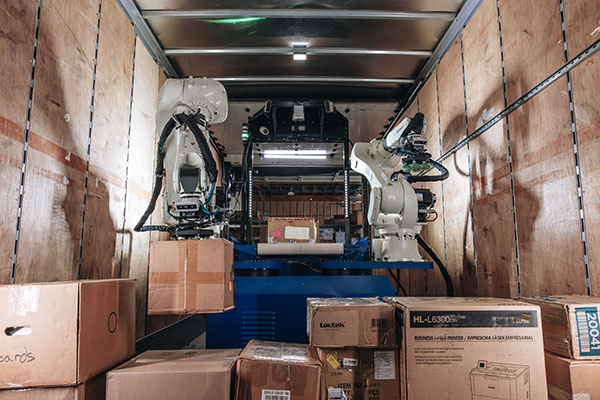
“We built a full truck loading game and allowed players to play, like our customers, our AI/ML engineers and our operators,” Ranjan added. “That also gave us a lot of information related to learning. And then we also collected a massive amount of package data, like package characteristics, like damages of packages, types of packages and more. Eventually, all that information went into training the models that we built.”
As DexR picks up a box and gathers pertinent data, including weight, shape, package material, package condition and more, the AI software assesses billions of wall shape possibilities to pack the trailer in the optimal way. And, it does this thinking in a fraction of a second.
Thanks to the dual arm design and mobile platform, DexR is able to build multiple walls at the same time and maneuver with precision forward and backward through trailers. With each box and truck build, the robot’s machine learning gathers more information, allowing Dexterity’s platform to digest and interpret the data for future builds.
“When you think about how AI and machine learning works in this thing, there's a lot of focus on action generation,” Ranjan said. “What are the possible sets of actions, given the number of boxes that you can foresee coming, given the state of the wall that is in front of you or state of the load that is in front of you? And then, what is the most optimal set of actions that are feasible in the constraints that you're working with?
“We eventually landed on reinforcement learning based models, which allow it to be very general, in terms of different kinds of load quality,” Ranjan added. “A generalizability of that model was super important for us, because at the end of it, we don't want to be building very specific local models, which work for one scenario and don't work for the other scenario. You have to have generalized models where you can scale throughout the massive network of some of our customers.”
Out of the box (truck)
Along with the confines of the truck for loading boxes, DexR can also be used in other scenarios at the loading dock or in the warehouse. As Ranjan described, “Think about Dex at the highest level, and think of it as an iPhone or an Android system. And then the applications are the applications that you deploy on it.”
“DexR is able to work in multiple locations,” Perry added. “So you're not having to buy one robot system for every single door that you're loading, and have the ability to use one piece of technology in multiple locations. Now, the way to expand that even further is not only going to multiple locations, but multiple applications. One piece of robotic hardware that's able to do a lot more than just the one thing that you bought it for.”
The system’s maneuverability allows customers to deploy DexR across multiple locations in the warehouse and let the robot’s motion planning come to life. The robot is equipped with several sensors and cameras to navigate safely through environments, and steer clear of obstacles and humans. The robot arms’ motion planning capabilities optimize the arm movement and trajectory as it picks and places boxes in a truck, or elsewhere.
The collaborative effort between DexR and loading dock staff has helped organizations like FedEx improve their truck loading capabilities, and Dexterity’s AI models to continue learning more about the optimal brick layering and wall design.
There’s a lot more to DexR than just “another brick in the wall.”
Want to learn more about cobot arms? This article was featured in the April 2024 Robotics 24/7 Special Focus Issue titled “Collaborating with robot arms, platforms.”
About the Author
Follow Robotics 24/7 on Linkedin
Article topics
Email Sign Up

